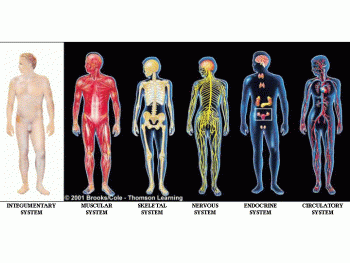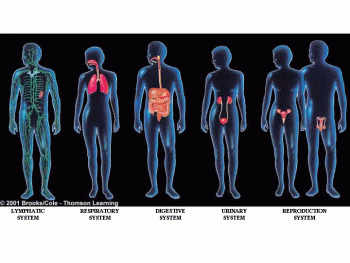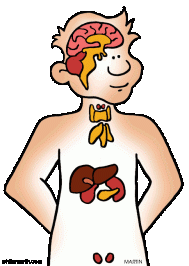For my next couple posts, I will focus my attention on the body systems. There are ten major systems of the body; each is very unique and crucial in our being. These systems work together and separately to allow us as humans to live, and give us the many abilities that we are capable of doing. Flaws in any one of these systems would cause our whole body to suffer.
Circulatory System
- Includes blood circulation involving the heart, blood vessels, and blood. This also includes subsets: lymphatic system and immune system.
Integumentary System
- This is the dermal region that includes the skin, hair, and nails.
Digestive System
- The digestive system is composed of many different arrangements that include any structures that assist in eating, drinking, processing, and expulsion. This would include the mouth, stomach, liver, intestines, etc.
Endocrine System
- Includes hormones and the glands of the body.
Excretory (Urinary) System
- This system contains the skin, lungs, kidneys, and large intestine.
Muscular System
- Includes muscles and tendons and works in conjunction with the skeletal system.
Nervous System
- This involves nervous tissue of the brain, spinal cord, and the many nerves throughout the body.
Reproductive System
- In men this refers mainly to the testes and penis.
- In women this refers mainly to the ovaries and uterus.
Respiratory System
- This system includes structures that assist breathing and gas exchange. These would involve the trachea, lungs, mouth, pharynx, etc.
Skeletal System
- This includes the bones, joints, ligaments, and tendons of the body and works in conjunction with the muscular system.
For this particular post, I will be specifically discussing the Endocrine System. This system has glands that produce hormones that then influence body functions. Your growth, sleep schedule, chemical balance, metabolism, reproduction, and more are controlled by the endocrine system. One other important function of the endocrine system is its activity in converting calories into energy. This system functions through the use of eight major glands: Pituitary, thyroid, pineal, thymus, hypothalamus, pancreas, adrenal glands (2), and the testes or ovaries.
Endocrine disorders are usually separated into two categories:
- Disease due to gland activity that leads to a hormone imbalance.
- Disease due to tumors or nodules that can affect the levels of hormones in the body.
Diabetes:
There are many endocrine disorders, yet most serious conditions are very rare. Diabetes is the most well known endocrine disorder. Diabetes results from high blood glucose levels. The pancreas normally releases the hormone insulin that transports sugars from the blood to the cells. When the pancreas or insulin does not function properly, it results in diabetes.
This condition is separated into type 1 and type 2. Type 1 Diabetes is characterized by no (or a very small) production of insulin. This is genetically inherited unlike type 2 diabetes, which typically occurs later in life. Type 2 diabetes is when the insulin cannot accomplish its job of transporting sugars into cells.
Growth Disorders:
These disorders that affect the growth of an individual can have very negative effects. The pituitary gland is also known as the “master gland” and has many important functions within our body. One purpose of this gland is to release a hormone called GH or Growth Hormone. This hormone controls a person’s development and can result in gigantism or growth deficiency.
People may have an excess of GH due to a tumor on the pituitary gland. Death is not caused directly from gigantism. Rather most people with this condition live shorter due to cardiovascular struggles because the body is so big.
Osteoporosis:
Hormones can contribute to osteoporosis, where the bones of the body become weaker and more brittle. About 40% of women above the age of 50 will experience a fracture attributed to osteoporosis. Men have about a 25% percent chance of an osteoporosis related fracture. This can be due to hormonal imbalances such as a decrease of estrogen or testosterone as we age. Women become at higher risk of osteoporosis after menopause because of the estrogen reduction. Also, excess cortisol or long term steroid use can lead to this. Another cause is an overactive thyroid gland.
Hyperthyroidism:
This is essentially an overactive thyroid gland. This is found most commonly in women but it can occur in men as well. The major cause of this is Grave’s disease. This is when the immune system attacks the thyroid gland as if it’s an invader. The outcome of this is excess thyroid  activity. Hyperthyroidism is also commonly attributed to thyroid nodules that influence the hormone levels and make the gland hyperactive. Bulging behind the eyes is a common symptom of this disorder along with fatigue, weakness, trembling, anxiety, diarrhea, weight loss, and rapid heart rate.
activity. Hyperthyroidism is also commonly attributed to thyroid nodules that influence the hormone levels and make the gland hyperactive. Bulging behind the eyes is a common symptom of this disorder along with fatigue, weakness, trembling, anxiety, diarrhea, weight loss, and rapid heart rate.
Overview:
See below for a full list of endocrine glands and functions.
http://diabetes.webmd.com/endocrine-system-disorders
The following link can provide you with greater knowledge regarding the many different disorders and conditions relevant to the endocrine system.
http://www.hormone.org/public/conditions.cfm
Sources:
http://www.essortment.com/systems-human-body-63212.html


